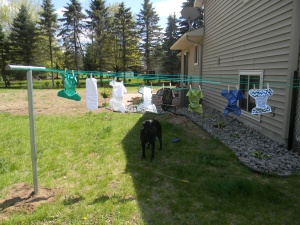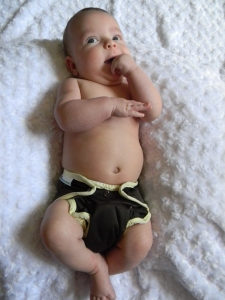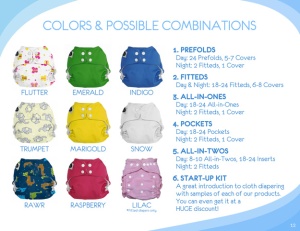I recently read an article that a friend posted on Facebook about the benefits of cloth diapers. When I first found out that I was pregnant my husband was very interested in cloth diapering, I on the other hand, was totally against it. I thought that it would be too messy and too much of a hassle, not to mention kind of disgusting. The knowledge that I had about cloth diapering was very minimal and skewed. So, we decided to go with disposables without a second thought.
After reading this article, I found myself actually considering switching to cloth. Here’s the link to the article: http://www.smallfootprintfamily.com/dangers-of-disposable-diapers#sthash.Bv9OH19X.gbpl. I couldn’t believe how much money we were wasting on diapers that we were just throwing away. We were basically spending hundreds of dollars on garbage. The money-saving aspect of cloth diapering was a huge draw for me. I am always looking for ways to cut costs and save money. According to another article I read, most parents will spend close to $1,500/year on diapers for their child. Cloth diapers cost anywhere from $200-$500 and can be used on multiple children. That’s savings in the thousands!
Not only was the money-saving a plus, but I also read that children who are cloth diapered tend to potty train sooner than those who wear disposables. This is because children can feel the wetness more in a cloth diaper than they can in a disposable, and that gives them the push to get out of the diapers faster.
Another benefit that I like is the environmentally friendly side of cloth. Our family is generating less waste and we are reducing our carbon footprint. Check our this visual to see how many diapers an average person uses on their baby. http://www.pinterest.com/pin/421649583833488835/?fb_ref=12033261412812955%3Ae437f085b512371e9ff8e71
If more people switch to cloth, waste from disposable diapers can be reduced.
I also like to line-dry my diapers to cut back on the drying costs and to increase their longevity. My husband and I put together a simple drying system in our back yard. Sun naturally bleaches out stains, which is another benefit of line-drying. I have had some crazy bright yellow and orange stains on my diapers that the sun completely got rid of. In the winter months, or when it is not so nice outside, I plan to rig up something in my basement to air dry my diapers.

So, are you thinking about switching to cloth? The modern world of cloth diapers can be a bit overwhelming. There are so many options! I was definitely overwhelmed when I first got started. Thankfully, I have a few friends who use cloth diapers and they really helped me out.
Here is my little blurb on how I got started and how I built my cloth diaper stash.
The most eco-friendly/inexpensive way to go with cloth diapering is to use covers and prefolds. If you go this route, you will need approximately 9-10 covers and 18-24 prefolds. It all depends on how often you want to do laundry. The prefolds are the absorbent part of the diaper (the actual diaper itself) that go inside a waterproof cover. Covers can be reused multiple times before you need to wash them, since the waste doesn’t go directly on the cover.
I currently have 6 bamboo/organic cotton prefolds and 3 covers. I also have 18 inserts and 6 covers that are specifically for the inserts. The inserts simply snap into the covers. This system (the Best Bottom diapering system by Nickisdiapers) is very easy to use/understand and the diapers are significantly less bulky than prefolds. I do laundry every other day. I want to get some more prefolds so that I do not have to do laundry as often. It is recommended that you do wash your diapers at least every 2-3 days to help prevent stains and keep the smell at bay.

This is my laundry routine:
1. Flush any solids into the toilet and/or use a diaper sprayer (not necessary with exclusively breastfed babies because their poop is water-soluble) Wash on cold/cold heavy setting with the highest amount of water without detergent
2. Wash on hot/cold heavy setting with the highest amount of water (you want your diapers and your water ratio to be that of a stew consistency, not a soup, adjust your water level accordingly) and use detergent (I use Tide) check with your diaper manufacturer to see what they recommend if you think you might want to return any. If you aren’t going to return your diapers you can use whatever detergent you want. It is a MYTH that you need to use cloth diaper “safe” detergents. In my opinion this is a money making strategy that cloth diaper companies use.
3. Rinse on warm or cold with the highest amount of water (again, you want a stew consistency, not a soup)
4. Do an additional spin/drain cycle if you want to cut back on your dry time
5. Line dry, put natural materials in the dryer after line drying to fluff them up (they tend to get crunchy after line-drying) You can also use wool dryer balls to help soften your diapers naturally and cut back on dry time.
I bought all of my diapers from nickisdiapers.com. This is a great place to get diapers. I recommend starting out with a few different kinds of diaper choices and deciding what works best for you. I ended up liking everything that I got. If you don’t like what you bought there is a policy where you have 15 days to use, wash, and return your diapers, if you aren’t in love with them.
Here are some places that you can purchase diapers:
- nickisdiapers.com (most diapers made in the USA, diapers ship from New Glarus, WI)
- alvababy.com (very inexpensive diapers that are made in China)
- http://www.littleneetchersdiapers.com/ (diapers ship from Minnesota)
- amazon.com
- zulily.com
Here is a list of your options for diapering, at least the options I am aware of:
- AI0 Diaper (All in one) – these diapers are essentially just like disposables. You use them once and then wash them. They are the most expensive option and you will need to purchase about 24 of these
- AI2 (All in two) – this is the cover/insert system that I have. It is more expensive than prefolds, but it is very convenient and less bulky. With this system there is a cover and an insert (the absorbent part) that snaps into the diaper or lays flat. I like the Imagine brand from imaginenickisdiapers.com.
- Fitted diaper – a fitted diaper is similar to a prefold except it has snaps or some closure system that keeps it closed. You will still need to purchase a waterproof cover to put over the fitted diaper. These diapers can be great for nighttime to keep in wetness if you have a baby who is a heavy wetter or one who squirms a lot.
- Prefolds – this system is the least expensive. You will need to buy about 18-24 prefolds and 9-10 covers. I really like the nickisdiapers bamboo/organic cotton prefolds and the bumgenius flip diaper covers.
- Pocket diaper – a pocket diaper is similar to the AI2 system. The pocket diaper has a pocket that you put an absorbent insert into. I have one pocket diaper that I occasionally use at night.
You will also want to purchase a diaper pail and 1-2 liners to keep your dirty diapers in. I have 1 pail with 2 liners so that I can just throw the liners with the dirty diapers right into the wash. I also have some wet bags to keep dirty diapers in when I am out and about.
If you want/need to use diaper creams, make sure that they are cloth diaper safe, or use a liner (either disposable or reusable) in between baby and the diaper. Diaper creams can coat diapers making them less absorbent and damaging them. I use fleece liners, which also help wick moisture away from my little man. One great item to use is coconut oil. It is all natural and will not coat your diapers. It works wonders on rashes and redness!
Nighttime diapering is a bit trickier than daytime diapering and it will likely take some trial and error. The first night we tried cloth I put my son in a pocket diaper with a microfiber insert and a thirsties bamboo prefold on top of that. He woke up with his little man parts inflamed and red. I took him to the pediatrician just to make sure he didn’t have an infection. She thinks it was just irritation from the extra moisture that cloth can cause.
Now we use an AI2 diaper at night with an extra overnight microfiber insert. My little man was a bit red this morning, but he has improved drastically from night one. We use a microfiber overnight insert on the bottom of the diaper with a hemp/organic cotton insert on top. We add an extra layer of fleece to keep moisture at bay. This method has worked great so far with no leaks!
I know this post was a bit lengthy, but I had a lot to say about what I have learned so far. I am really enjoying cloth diapering and I am so glad that we made the switch. You just can’t beat the cuteness factor that cloth diapers have. They are way more adorable than disposables! If you want to get started cloth diapering, but are overwhelmed or aren’t sure how, feel free to contact me and I can do my best to help you or direct you to someone who can help you.
 Warren in his Chunky Monkey Best Bottom Diaper
Warren in his Chunky Monkey Best Bottom Diaper
 Me and Warren on our first day with cloth
Me and Warren on our first day with cloth





